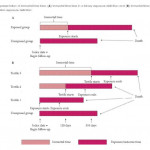Editorial: Immortal-Time Bias – A Crucial Yet Overlooked Confounder in Urological Research
The measurement of treatment effect through observational studies has become commonplace in the medical literature. These cohort studies provide valuable data on outcomes that can be difficult to assess in randomized controlled trials, such as long-term mortality. Accurate interpretation of observational data, however, requires accounting for potential confounders of study design, including the immortal-time bias. In this issue of BJUI, Wallis et al. [1] show how accounting for this bias can influence the measured effect of cumulative testosterone exposure on mortality. The implications of their findings extend to several other studies, whose designs may also be subject to immortal-time bias.
‘Immortal time’ refers to the portion of a follow-up period during which an outcome could not have occurred (e.g. subjects in the ‘exposure group’ cannot die before they receive the exposure); thus, potentially allowing the artificial magnification of an effect on the study outcome [2]. As the authors point out, this concept is not new. It was first identified several decades ago to highlight how a study’s finding of a survival advantage for patients undergoing heart transplant was nullified once immortal time was properly accounted for [3]. Despite its long existence in epidemiological teachings, the authors cite several studies both within and outside of the urological literature that have failed to appropriately account for this bias. Many of these studies employ binary exposure variables, but Wallis et al. delve into relatively uncharted territory by examining the effect of immortal-time bias on multi-level categorical exposures.
The relationship between testosterone replacement therapy (TRT) and mortality, the focus of the accompanying study, is apt because it is a controversial topic that weighs heavily on an accurate assessment of the therapy’s risks and benefits. The authors, using data from their own prior study, show that this delicate balance can be easily tipped when immortal-time bias is not properly accounted for. In their analysis, the overall result was the same regardless of controlling for this bias; men in the lowest tertile of TRT exposure had a higher risk of mortality, and those in the highest tertile had a lower risk of mortality; however, use of a time-fixed as opposed to the more appropriate time-varying analysis led to a substantial magnification of the effect size in each direction. While the overall result may have been the same in this example, the authors cite other instances of high-impact research whose published conclusions were shown to be completely different once accounting for immortal-time bias [4]. One can easily imagine how this type of erroneous data analysis could have deleterious consequences in the clinical setting. Healthcare providers rely on research to make decisions that have far-reaching impacts on patients’ lives. This study highlights the importance of ensuring that such analyses are carried out properly so that patients can receive the high-quality, evidence-based care they deserve.
The authors should be commended for taking the time to deconstruct and evaluate an analytical concept that is pertinent to study designs across several disciplines. Much of the research published today seeks to find answers to important clinical questions, but not nearly enough investigation is devoted to verifying that the analyses to obtain these answers are conducted properly. Urology in particular is a field that is still maturing with respect to the use of secondary data analytical techniques, such as propensity score models and instrumental variables [5]. To sustain our improvement in investigative skills alongside our fellow medical disciplines, we must pay special attention to studies that hold a magnifying glass to commonly used methodologies in the urological literature. In a similar vein, there have been increasing efforts recently to improve the process and transparency of corroborating the results of scientific studies, and these authors’ findings reinforce why these efforts are so crucial. If we expect to continue pushing forward the boundaries of medical research, it is our duty to ensure that our analytical methods are as rigorous and accurate as possible.



